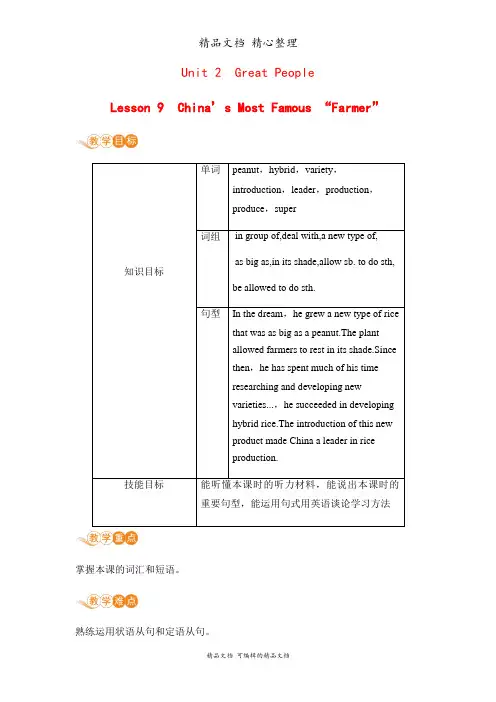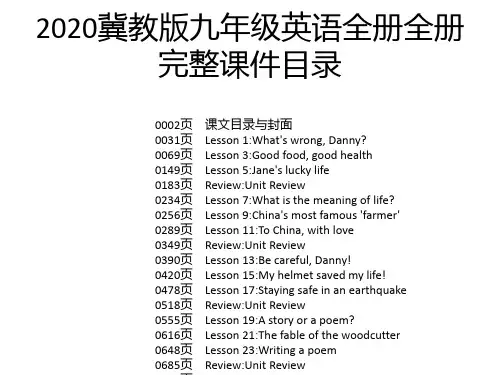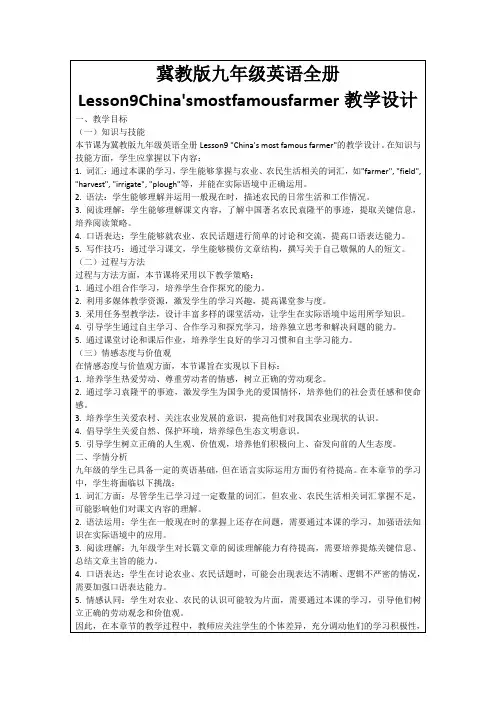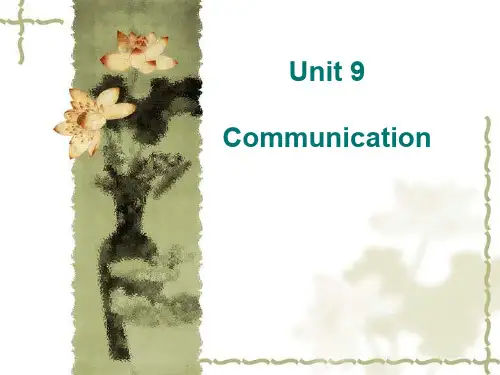2020年冀教版九年级英语全册第九单元教案
- 格式:doc
- 大小:73.50 KB
- 文档页数:5

Lesson 9 China’s Most Famous “Farmer”Teaching Contents:1. words: introduction, leader, produce, peanut, hybrid, variety, production, super2. patterns: since then, together with, in the+年代’sTeaching Objectives:1. Grasp mastery words and patterns.2. Enable to tell something about Y uan LongpingLESSON STRUCTURECLASS OPENINGFor ideas and tips on beginning a class, see "Teaching Techniques" at the back of this teacher's guide. KEY STEPSStep1. Show the new words with the flashcards. Let the students read the words and expressions after you. Read more times to the difficult words.Play a game to see if they have read them fluently. Divide the class into two groups. One group asks the words, the other answers. Then change their roles. They get one score if they can read a word correctly. At last, let’s see who has the higher score. The winner is the group who gets more scores.Step2.Skim the text and tell us the main idea of this lesson.Give the students three minutes. Let’s see how many students can finish the reading task in the limited time.Ask some students to demonstrate their opinion. If others think isn’t complete, they can add others in the opinion. If the teacher thinks their answers are not perfect, he or she can pay more attention to the part in the next steps.Step3.Read the text and ask questions.Finish the task in groups. Find questions about this part. Then ask the other group to answer them. If someone wants to add his own opinion, he can stand up and say his suggestion.The questions are like these:What’s Professor Yuan’s childhood dream?When was he born?What did he succeed in developing?Did foreigner countries use Professor Y uan’s technology?They can ask more questions as they like.Step4. Make sentences with the language points with the help of the flashcards.graduate fromI graduate Beijing University in 2021.Where did he graduate from?come up withAt last, he came up with a good idea.When we are in trouble, he always comes up with good ideas.in the field ofHe is famous in field of art.since thenThe man has worked in that factory since then.together withThe girl moved to France together with her parents.in the+年代+sThe scientist was born in the 1980s.Step5. Play the tape for several times. Let the students listen carefully and have the correct pronunciation. Let some students read important paragraphs.Step6. PracticeFinish Exercise 1, 2 and 3 on Page 23. Encourage students to do them independently. Then check answers as a class.Step7. HomeworkFinish off the activity book.Go on the next reading in the student book.Summary:It is necessary for us to study the performance. What have the old scientists done for us? How great they are? We must work hard at all our subjects. Whatever you do when you grow up, we must devote ourselves to the society. We must be a useful person to the world. If someone is very interested in rice, too, we canget more information on the Internet.。

冀教版九年级unit9知识点冀教版九年级的unit9是一个涉及不同主题的单元,包括课文阅读和语法知识学习。
本文将介绍unit9的主要内容和学习重点,帮助学生更好地理解和掌握相关知识。
一、课文阅读unit9的课文包含了两篇文章,分别讲述了体育和传统文化方面的话题。
第一篇文章是关于体育锻炼的重要性,强调运动可以提高身体健康并培养团队合作精神。
第二篇文章是介绍中国传统剪纸艺术的,讲述了剪纸的起源和发展历史,以及剪纸在中国传统文化中的重要地位。
通过阅读这两篇文章,学生可以提高阅读理解能力,学习如何从文字中获取关键信息。
同时,课文也提供了一些生词和短语,帮助学生扩展词汇量和表达能力。
二、语法知识除了课文阅读,unit9还包括一些重要的语法知识。
其中包括以下几个方面:1. 动词的时态和语态:学生需要掌握一般现在时、一般过去时和一般将来时的用法,以及被动语态的构成和应用。
2. 介词和介词短语:学生需要学习常见的介词用法和介词短语的搭配,以便正确地表达位置、时间和原因等概念。
3. 定语从句和状语从句:学生需要学会使用定语从句和状语从句来修饰名词和句子,从而丰富句子结构和表达能力。
4. 情态动词:学生需要学会使用can、could、may、might、will、would等情态动词,以表示能力、建议、推测和礼貌等意义。
通过掌握这些语法知识,学生可以提高句子的准确性和流利度,使自己的表达更加清晰和有说服力。
三、学习方法在学习unit9的知识点时,学生可以采用以下几种学习方法:1. 积极参与课堂讨论:在课堂上积极提问和回答问题,与老师和同学一起交流思想,共同理解和探讨新知识。
2. 多读多写:通过大量阅读和写作练习,巩固课文中的词汇和句型,提高语言表达能力。
3. 制定学习计划:根据自己的时间和能力,合理安排学习任务,逐步攻克难点,确保学习质量和效果。
4. 运用学习工具:利用电子词典、英语学习软件等学习工具,辅助理解课文和掌握语法知识,提高学习效率。

Unit 2 Great PeopleLesson 9 China’s Most Famous “Farmer”单词peanut,hybrid,variety,掌握本课的词汇和短语。
熟练运用状语从句和定语从句。
Step 1:Leading-in1.根据图片,复习并呈现上一节课所学的句子。
2.多媒体展示“水稻之父”袁隆平的图片。
T:Boys and girls,look at the picture.Who is he,can you tell me?Ss:Yes.He is Yuan Longping.T:Yes,very good.What is he famous for?Ss:A new kind of rice.T:Why is the rice special?Ss:...T:OK.Let’s learn Lesson 9 to learn about it.Ready?Go!设计意图:根据图片导入本课话题,师生互动,激发学生的学习兴趣,创设轻松的学习氛围,开发他们的最大潜能,从而使这堂课在最大程度上达到最高效能。
Step 2:Pre-reading在屏幕上呈现更多的问题,让学生根据问题旁边的图片,试着理解这些问题。
老师可以适当给予帮助,对新单词和一些词组可以给出提示。
设计意图:向学生展示本课的重要词汇以及它们所处的情景,帮助学生学习新单词和重要句型,为下面课文的学习做好准备。
Step 3:While-readingTask 1 Read and do Exercise 1 on Page 23.设计意图:培养学生快速阅读短文提取文章大意的能力,此环节老师可以对学生进行阅读策略方面的指导。
Task 2 Read the article aloud after the recorder.Let the students listen to the tape and repeat it sentence by sentence,then read it aloud by themselves.给学生播放录音,学生跟读,学生起立模仿,小组间进行竞争,评出“朗读之星”。







Teaching Plan of Lesson 9, Unit 2, Year 9China's Most Famous 'Farmer', Yuan Longping工布江达县中学杨文辉2018年9月Part 1: Analysis the teaching materialThis unit mainly talks about Great People and their lives.After learning the unit, the students will set their goal and know how to achieve their goals. They learn to be a good and useful human being in the world and be devoted to the world. This lesson tells us the famous man Yuan Longping.Part 2: Teaching and learning goals:1.Knowledge aims.enable the students to master new words, phrases and sentence patterns.enable the students to understand the content of the textAll: 1) Able to read about and understand the famous farmer Yuan Longping;2)Learn the new words and phrases3)Learn from Dr. Yuan to be a great manMost: Able to read and talk on the passage freelySome: Able to talk and write about a famous person2.Abilities aims.to develop the students’ abilities of listening, speaking, reading and writing. They can use words and phrases to talk about sth. related to the text and our own life..to develop their abilities of discuss and draw a conclusion.3.Emotion aims.help the students to understand the importance of having a dream..encourage the students to learn from Dr. Yuan.Part 3: Analysis the studentsThe students in our class are not good at English. The have difficulty in following me in English. So I have to speak slowly and use simple English. But I have to keep on using English in class.Part 4: Teaching methodsTask-based Teaching Method, Reading Comprehension Method, Situational Teaching MethodPart 5: Learning methodsgroup learning, pair work, individual work, discussion and reportPart 6: Teaching proceduresStep1: Self-studyTask 1: Read the text and write true (T) or false (F) according to the text.1.He grew a new type of rice as a child. ( )2. He had an idea for hybrid rice in the 1960s. ( )3. He studied agriculture at university. ( )4. He succeeded in developing hybrid rice by himself. ( )5.He is working hard on developing super hybrid rice. ( )6. He plays the violin for half an hour before he goes to bed. ( )Task 2: Match the English words with the Chinese meaningStep 2: While learningTask 3: Reading comprehension. Choose the best answer.1. Paragraph One mainly tells us that ___.A. Yuan Longping had a dream when he was a child.B. Yuan Longping became the' Father of Hybrid Rice'.C. the plant of the new type of rice allowed farmers to rest in its shade .D. Yuan Longping grew a new type of rice.2.In Paragraph Two, “Since then, he has spent ...”, the word 'then' refers to ?A. when he was a child.B. when he studied in agriculture at university.C. in 1973.D. in the 1960s when he came up with an idea for hybrid rice.3.Why did he become known as the“Father of Hybid Rice”?A. He came up with an idea for hybrid rice.B. He spent time researching and developing new varieties.C. He succeeded in developing hybrid rice , together with other scientists.D. He is working on developing super hybrid rice.4.Which is the most probable reason why Yuan Longping works on developing hybrid rice?A. He is interested in growing rice.B. He studied growing rice at university.C. He wants to help people out of hunger in the world.D. He hopes to make lots of money.5.What is the main idea of the text?A. Yuan Longping had a dream.B. Yuan Longping succeeded in developing hybrid rice.C. Yuan Longping is China's most famous 'farmer'.D. Yuan Longping loves playing the violin, listening to music and reading.Language points:1.allow sb. to do 允许某人做某事allow doing sth. 允许做某事2.in the 1960s 在20世纪60年代3. come up with: have; think of 产生,发现4. be/become known as... 作为......而闻名be/become known for... 因为......而闻名be/become known in... 在......地方闻名5. work on 从事于;致力于Task4: Exercises of the language pointsEx 1.Fill in the blanks with proper words.1.We don't allow people fish in the lake.2. the 1840s, there were many famous artists.3.I came up an answer to the question.4.Mo Yan is known a famous writer his Nobel Prize.5.Scientists are working solving the difficult problem.Ex 2. Complete the sentences with the given words.1.We don't allow (cheat) in the exam.2.My parents don't allow me (stay) up too late.3.Our country is working on (improve) people's life.4.Einstein is (know) as a famous scientist.Task5: RetellingStep 3: After learningTask6: Discussion1.Why is Dr. Yuan a great man?What can we learn from Dr. Yuan Longping?2.Do you have a dream? What's it? How can we succeed in realizing our dream?HomeworkWrite a passage: China's Most Famous 'Farmer',Yuan LongpingWrite a passage: A famous ..., ...The good points: 1. The lesson is carried on in English, which is good for the students to develop their listening ability. 2. It is good to have competitions between 6 teams. 3.The text is well dealt with, including the language points and reading comprehension.The poor points: 1. There is too much to do in the lesson, so the teaching task is not finished. 2. Some of the students arenot able to follow the teacher. 3. More time should be given to the students to experience learning.。

冀教版九年级英语教学教案5篇冀教版九年级英语教案1一、教学目标:1. 语言知识目标:1) 学习掌握下列词汇:cream, workday,pie, show up, bean, market, by the endof,2)进行一步复习巩固学习Section A 部分所学的生词和词组。
3)巩固过去完成时的用法2. 情感态度价值观目标:1)能运用所掌握的语法,句型和词汇进行交流。
2)能比较流利地讲述自己曾经有的特别的经历。
二、教学重难点1. 教学重点:1) 复习巩固Section A 部分所学的生词和词组,达到熟练运用的目标。
2) 总结过去完成时的不同句型。
3)总结过去完成时的用法。
2. 教学难点:过去完成时的用法三、教学过程Ⅰ. Revision1. Have adictationof the new words learned in the last class.2. Review somemainphrases we learned in the last class. Check the homework.把下列短语翻译成英语1. 即将2. 倒杯咖啡3. 排队等候4. 起床5. 出去6. 迟到7. 到时候 8. 闹铃响9. 开始做某事 10. 搭便车3. Revision过去完成时的构成:had+动词的过去分词II. Lead-inT: What happenedtoyou on a bad morning?Ss…引导学生用过去完成时回答。
III. GrammarFocus.1. 过去完成时讲解。
2. 学生阅读Grammar Focus中的句子,然后做填空练习。
1)当我到达学校的时候,我才意识到我把书包忘在家里了。
When I gottoschool, I realized I ______ ______ my backpack at home.2)到我返回学校的时候,铃声已经响过了。
_____ _____ _____Igot back to school, the bell ______ _______.3)我到达公共汽车站之前,汽车已经离开了。
Unit 9 CommunicationLesson 49 Get Along with Others◆教材分析1. Analysis of the StudentsThe students of Grade 9 hav e mastered certain vocabularies,expressions and structures. They also have the abilities of self-teaching and working in groups. Most of them are willing to express their opinions in English.2. Analysis of Teaching ContentLesson 49 is the first lesson in Unit 9, Book 5.This unit focus on the subject Co mmunication. Students cares about the subject because it is close to everyone. Lesson 49 mainly talks about how to get along with others in school or at home.◆教学目标【知识目标】1. To master the words : unit, misunderstanding, require, communication, hardly, solution, anger, hardly.2. To master the phrases: get along with, be satisfied with, in the open, come to a solution, move on.【能力目标】Improve the students’ability of speaking, listening, reading and writing. To learn about how to get along with others.【情感目标】To realize the necessity of getting along with others and the ways of making friends.【教学重点】To master the words and phrases.【教学难点】To learn how to get along with others.◆课前准备Tape recorder, Multimedia◆教学过程Step 1. Warm-up1.Show the picture of my friend, let students introduce her.2.Ask students: Do you have good friends? Introduce your friends.3.Free talk: (1) Do you have good relationships with the people in your life?(2)What do you think is most important for a good friendship?Step 2. Presentation1.Explain the words according to the pictures.2.Listen to the tape and tell us what the main ideas of three people.3.Read and match the people with their statements.4.Check the answers.5.Explain the language points:get along (with) 意为“(与某人)和睦相处”。
Unit 9 CommunicationLesson 49: Get Along with OthersI. Learning aims:Master the new words:topic, misunderstand, realize, require, satisfy, communicate, exactly, solution, hopefulII. Learning important and difficult points:1) How do you get along with others in school or at home?2) Friendship requires good communication..3) I guess that people who know how to communicate well with others are happier and more satisfied with theirlives.4) Bad feelings like hate and angry can make you seriously ill.Language Points:1. require【用法】作及物动词,意为“要求、需要”,后加名词或代词作宾语。
【举例】If you require more information, you can ask Mr. Zhou. 如果你需要更多的信息,你可以问一下周先生。
【拓展】当用表示物的词语作主语时,require 后加动名词表示“需要被做”,用主动形式表达被动含义,此时它与need 同义。
【举例】This room requires painting. 这个房间需要粉刷了。
2. How do you get along with others in school or at home? 你在学校或家里和他人相处得怎么样?【用法】句式get along with 与get on with同义,意为“和……相处”或表示“……的进展情况”,如果表示相处融洽或进展顺利要用副词well加以修饰。
Unit 9 CommunicationLesson 49: Get Along with OthersI. Learning aims:Master the new words:topic, misunderstand, realize, require, satisfy, communicate, exactly, solution, hopefulII. Learning important and difficult points:1) How do you get along with others in school or at home?2) Friendship requires good communication..3) I guess that people who know how to communicate well with others are happier and more satisfied with theirlives.4) Bad feelings like hate and angry can make you seriously ill.Language Points:1. require【用法】作及物动词,意为“要求、需要”,后加名词或代词作宾语。
【举例】If you require more information, you can ask Mr. Zhou. 如果你需要更多的信息,你可以问一下周先生。
【拓展】当用表示物的词语作主语时,require 后加动名词表示“需要被做”,用主动形式表达被动含义,此时它与need 同义。
【举例】This room requires painting. 这个房间需要粉刷了。
2. How do you get along with others in school or at home? 你在学校或家里和他人相处得怎么样?【用法】句式get along with 与get on with同义,意为“和……相处”或表示“……的进展情况”,如果表示相处融洽或进展顺利要用副词well加以修饰。
【举例】How are you getting on with your work? 你们的工作进展如何?3. I guess that people who know how to communicate well with others are happier and more satisfied with their lives. 我猜想能与别人很好地交流的人会很幸福并且对他们自己的生活也会更加满意。
【用法】这句话中的I guess 是主句,后面的that people who know how to communicate well with others are happier and more satisfied with their lives 是宾语从句;宾语从句中的主语是people,后面的who know how to communicate well with others又是定语从句,作定语,修饰前面的名词people。
句中的句式be satisfied with 与be pleased with 同义,意为“对……感到满意”。
【举例】I think the radio that is made in Shanghai is the best. 我想上海生产的收音机是最好的。
Lesson 50: Tips for Good CommunicationI. Learning aims:Master the new words:comfortable, interpersonal, passport, proper, listener, truth, waste, promise II. Learning important and difficult points:1) Make a great effort to do this when you first meet someone new.2)The main thing is to find a topic you are both interested in.3)One simple way to show you are a good listener is to make eye contact.4) If you set a time to meet your friends, do your best to be on time.Language Points:1.. promise【用法】作可数名词,意为“诺言、承诺”,复数形式是promises。
【举例】You should keep your promise in life. 生活中你应该恪守你的承诺。
【用法】作及物动词,意为“承诺、答应”,后加不定式或宾语从句。
【举例】She promised to help me with my English. 她答应在英语方面帮助我。
2. The main thing is to find a topic you are both interested in. 主要事情是找到一个你们两个都感兴趣的话题。
【用法】句中的to find a topic you are both interested in是不定式用在系词后作表语;其中的you are both interested in 是定语从句作定语,修饰前面的名词topic。
【举例】You can choose a topic that you are fond of. 你可以选择一个你喜欢的话题。
3. One simple way to show you are a good listener is to make eye contact. 说明你是一个好听众的一个简单的方法是让你的眼睛接触对方。
【用法】句中的to show you are a good listener是不定式短语作定语,修饰前面的名词way;不定式中的you are a good listener 是宾语从句,作动词show的宾语;后面的不定式短语to make eye contact作表语。
【举例】The best way to make progress is to study hard. 取得进步最好的方法是努力学习。
Lesson 51: What Could Be Wrong?I. Learning aims:Master the new words:figure, experience, situation, directly, misunderstand, hallwayII. Learning important and difficult points:1) We used to study and play together all the time, but ever since last Friday.2) Sometimes it’s pretty hard to tell what’s wrong in a friendship.3) If your friend wants to end the friendship, there’s nothing you can go about it.4) Say hi to her when you pass her in the hallway at school.Language Points:1. situation【用法】作可数名词,意为“情况、形势、局面、处境”,复数形式是situations。
【举例】We have never met this kind of situation before. 我们以前从没有遇到过这种情况。
2. We used to study and play together all the time, but ever since last Friday. 我们过去曾经一起学习过、玩过,但从上个星期五就不一样了。
【用法】used to的意思是“过去经常”,后加动词原形,它可以用于各种人称之后。
它的否定句式和疑问句式可以有两种变化形式:否定句:used not to + 动词原形didn’t use to + 动词原形疑问句:Used + 主语+ to + 动词原形?Did + 主语+ use to + 动词原形?【举例】①He used to live in this small village. 他曾经住在这个小村子里。
②He used not to live in this small village = He didn’t use to live in this small village.他过去不曾住在这个小村子里。
③Used he to live in this small village? =Did he use to live in this small village? 他曾经住在这个小村子里吗?【拓展】与used to相似的句式是be used to,它的意思是“习惯于”,后加名词、代词、动名词作介词宾语,并且它有各种时态的变化。
【举例】①She is used to the life here. 她习惯了这里的生活。
②She has been used to living here. 她已经习惯住在这里了。
③You’ll be used to work here.你会习惯在这里工作的。
3. Say hi to her when you pass her in the hallway at school. 当你在学校的走廊里从她面前走过时,要和她打声招呼。
【用法】句式say hi to…意为“和……打招呼”,其中的hi可用hello替换。
【举例】Bill said hello to me when he saw me. 比尔一看到我就和我打招呼。
【拓展】类似句式还有:say goodbye to…向……告别;say sorry to…向……表示道歉;say thanks to…向……表示感谢;say no to…拒绝……;say yes to…同意……【举例】Why did you say thanks to her again? 你为什么又向她表示感谢?Lesson 52: The Power of a SmileI. Learning aims:Master the new words:difficulty, adapt, universal, simply, beginningII. Learning important and difficult points:1) If you are not part of a group, it can be difficult for you to be accepted.2) Before he arrived, he knew there would be many difficulties.3) Sam knew he had to find a way to change the situation.4) Soon the boy asked Sam to join him and his group of friends for lunch.Language Points:1. difficulty【用法】作可数名词,意为“困难”,复数形式是difficulties.【举例】I think you will meet many different difficulties in your work. 我想你在工作中会遇到很多不同的困难。